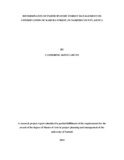| dc.description.abstract | play an important role in supporting livelihood of people and biodiversity. However, the concept
of the importance of conserving forests, as well as being part of the initiatives that promote
conservation of forests is yet to be understood by some communities and individuals, because of
their varied interests in the resource. This has led to more use of the forest resources, than they
can be replenished, causing deforestation. Studies have shown that communities that live in close
proximity to the forests are the ones who mostly benefit from the natural resource, but are also
the ones who are majorly affected by policies and regulations that give more power to the “rich”
in the society, in forest resource use access. The purpose of this study was to assess how
participatory forest management has influenced conservation of forests, while also looking at
some of the factors that determine the engagement and productivity of communities in
participating in conservation of forests. The study employed the descriptive survey design. The
target population was 875, with 425 being community households, and 450 being forest
management staff. The sample size was 269 based on the Krejcie and Morgan procedure, of
which 99, were forest management staff respondents, who were selected using the purposive
sampling technique, while the remaining 170 were community household respondents, selected
through the systematic random sampling technique. The main instrument to be used in the study
were questionnaires, whose reliability testing was be done using internal-consistency technique,
which was based on the Cronbach Alpha method of analysis. The method of data collection was
done through administering of questionnaires to respondents, with both closed and open ended
questions, which was then collected back and collated for analysis. The data analysis technique
to be used in this study was descriptive statistics, where the data was collated, coded and entered
into SPSS system software. Quantitative data was presented using percentages, graphs, and
frequency distribution tables, while the qualitative data was be presented in verbatim statements,
by quoting the exact responses given by the respondents. Findings from the study revealed that
the government was the leading stakeholder involved in participatory forest management of the
forest at (63.2%), followed by NGO‟s at (43%), while religious (10%) and learning institutions
(22%) played the least roles. The study also found that one‟s income level does influence the
conservation of the forest, i.e, majority of the respondents earn below 10,000, (40%), with their
major source of energy being fuel-wood (52.4%), which means that the lower the income levels,
the higher the pressure on the forest resources as they are deemed affordable. The study also
found out that women are more involved (31.5%) in conservation of the forest compared to men
at (15.5%). However, the study also revealed that there are more male leaders (58%) compared
to female leaders (43%) in the forest sector, an indication that women are still shy to be in
command of forest related activities, as stereotyping also plays and important in the reluctance of
women in taking leadership roles in the conservation of the forest. The study also revealed that
communities are mostly aware of the rules and regulations that affect them directly such as
charcoal rules (60.7%), but have very limited knowledge on other general forest rules and
regulations. Based on the findings above, the study recommends more community and
stakeholder empowerment towards conservation of the forest. Programmes targeting women and
girls from the community as well the management personnel should be encouraged, in order to
create confidence on female leadership in forestry. Furthermore, community needs and views
need to considered when establishing rules and regulations, so as to ensure that their interests in
the stipulated laws. There is need for transparency in stakeholder involvement and equity, in
order to avoid conflicts such as power and resource sharing, as well as land grabbing conflicts. | en_US |

